Abstract
A wide range of recent applications require high-quality sprays that are characterized by extremely small-sized droplets, a narrow droplet size distribution, and a short breakup length. Fuel injection systems in propulsion units, energy storage, medical implementations, printings, and coatings are just a few examples. Flash-boiling atomization is a unique method that was extensively developed during the past two to three decades and has been proven to generate high-quality demanded sprays. In flash-boiling atomization, the liquid is forced to reach a metastable superheated state by either rapid heating or rapid pressure drop, where vapor bubbles nucleate, become fast-growing, and subsequently break down the liquid into a fine spray in a very short time. This present article focuses on flash-boiling atomization via rapid depressurization, which is presently more relevant to energy systems. The field of flash-boiling atomization has seen rapid growth and popularity in the past two decades. The aim of this article is to quantitatively portray the landscape and evolutionary trajectory of flash-boiling atomization research and applications and to detect new research frontiers and emerging trends in the literature on flash-boiling atomization. We briefly review the basic theories of the flash-boiling atomization mechanism present a comprehensive overview of the field, from its birth in approximately the 1970s to the present, and provide a database comprising 386 articles published on the topic of flash-boiling atomization. We visualize the intellectual structure of flash-boiling atomization research and applications and track its evolvement over the past five decades, thus providing a global overview and a comprehensive understanding of the development of flash-boiling atomization research and emerging applications.
1. Introduction
Flash-boiling atomization is a method by which a liquid is brought into a superheated state, such as vigorous boiling [1], in a short timeframe while the bubbles grow considerably fast. This leads to the disintegration of the continuous liquid into tiny droplets. Flash-boiling, effervescent, and air-assisted atomization are based on a two-phase flow to achieve effective atomization. However, effervescent and air-assisted atomization are commonly referred to as atomization processes without the occurrence of a phase change. In effervescent and air-assisted atomization, the gaseous phase is introduced at a low (effervescent) or high (air-assisted) velocity into the flowing liquid stream [2].
The main advantage of flash-boiling atomization is its ability to generate an exceptionally finer spray [3], even with low (<15%) gas mole fractions [4,5] at extremely small pressure difference values [3,6]. Flash-boiling atomization has proven to offer many important advantages in practical systems where small-sized droplets and a narrow droplet size distribution are essentially required. It is a crucial quality for efficient fuel combustion, pharmaceutical applications, film coating, quality dyeing, printing, improved cold-start performance, and reducing the emissions of pollutants.
In this present article, we first outline the basic mechanisms and theories of flash-boiling atomization and discuss the various fluids that are used for flash-boiling atomization. After that, we present a brief review of the diagnostic aspects (Section 2) and provide an overview of the development of the research, topics, and applications (Section 3). This is followed by the conclusion section.
Over the years, a few notable books have been published on the different aspects of atomization processes [4,5,7,8]. Here, we focus on the flash-boiling atomization mechanism and discuss the various processes and applications that are more affined to the generation of sprays using thermal energy and the use of phase change via the depressurization of the liquid to stimulate intensive boiling and atomization.
2. Flash-Boiling Atomization—Mechanisms, Theories, and Current Challenges
The insufficient comprehension of the compound physical phenomena associated with flash-boiling atomization creates a gap in the essential knowledge that needs to be bridged in order to fully understand the whole process in detail.
2.1. Flash Boiling
Flash boiling occurs when the liquid is forced to reach a metastable superheated state via a rapid pressure drop that is well below its saturation pressure (grey area in Figure 1). Under these conditions, vapor bubble nucleation occurs, which leads to the formation of bubbles, their growth, and, subsequently, the breaking down of the liquid’s continuous phase into a fine spray. All in a very short time.
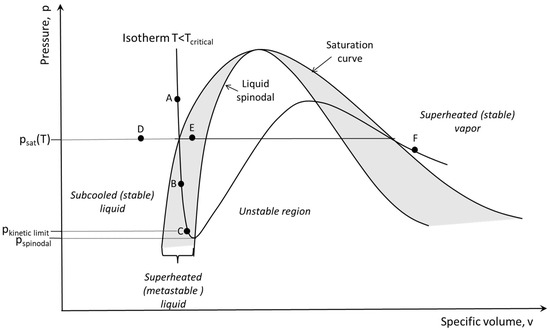
Figure 1.
Typical pressure–volume phase diagram, indicating a subcritical isotherm.
Reaching a metastable superheated state can be achieved through many different pathways. It is commonly accepted to divide these multiple paths into either isothermal depressurization (AB in Figure 1) or isobaric heating (DE in Figure 1), where the first is commonly used in practical spray generation systems [9] and is the focus of this present article.
The flash-boiling process, therefore, involves a rapid phase change in the liquid. Phase change via nucleation occurs once the superheated liquid encounters disturbances that are larger than the critical disturbance appropriate to its degree of superheating. Homogeneous nucleation at the kinetic limit (point C in Figure 1) occurs when the fluctuations serve as the critical disturbance on the verge of the spinodal curve [10]. It is, however, more likely that heterogeneous nucleation rather than homogeneous nucleation is the dominant mechanism in flash-boiling atomization processes because, in most commercial applications, depressurization is not fast enough to overcome the existing disturbances. The disturbances are developed almost instantaneously at nucleation sites that are usually present in dissolved gases, impurities, colloids, or surface roughness, which can be found almost everywhere in practical systems. In a homogeneous nucleation regime, pressure fluctuations at the molecular level form the nucleation centers. If the superheated liquid relaxes to finite-sized bubbles, it relaxes into superheated vapor (point F in Figure 1) to fulfill the equilibrium condition of equal chemical potentials in the liquid and vapor phases [11].
Despite the abundance of nucleation sites available in spraying processes, rapid processes can lead to near-spinodal degrees of superheating, depending on the degree of contamination of the fluid (colloids, dissolved gases, etc.) and the depressurization or heating rate (a few examples can be found in [10,12,13,14,15,16,17,18]). The spinodal (or kinetic limit, point C in Figure 1) pressure values may be negative (negative absolute pressures) for most operating conditions in some common applications, e.g., engines and pharmaceuticals, making it more challenging to reach spinodal limits in depressurization processes [19]. A few models were devised to predict the degree of superheating in the rapid depressurization of water in one atmosphere [20,21,22,23]. Figure 2 presents the minimal depressurization rate for which the kinetic stability conditions are met. The results are compared to the experimental results of Alamgir and Lienhard for water [20].
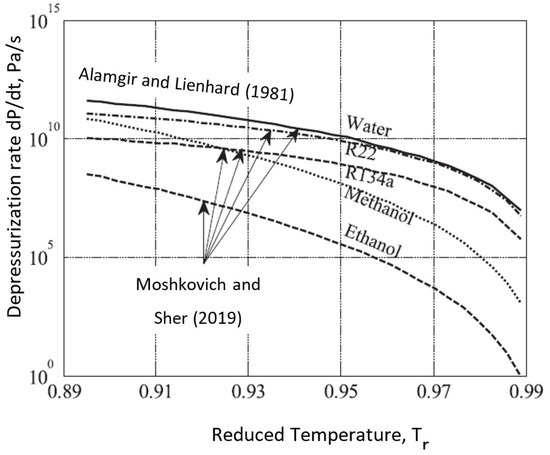
Figure 2.
Minimal depressurization rate for which the kinetic stability conditions are reached vs. the initial reduced temperature, as predicted by Alamgir and Lienhard [20] and Moshkovich and Sher [23] (modified from Moshkovich and Sher [23]).
The quality of spray is heavily influenced by the number of nucleation sites and the degree of superheating, which plays a significant role in determining the dimension of the active nucleation sites and the size of the initial bubbles. The number of nucleation sites determines the number of bubbles. When the two-phase mixture of liquid and bubbles flow either through a single or a twin orifice injector [1], it determines the relative velocities of the two phases, thus the shearing forces, and, therefore, ultimately affecting the effectiveness of secondary breakup mechanisms [24].
The stochastic nature of the nucleation affects the spray characteristics. Therefore, a more thorough understanding of the effects of the following main topics on the nucleation conditions in pure liquids, liquid solutions, fuel surrogates [25], and nano-fluids should still be pursued:
- Depressurization rate;
- Wettability;
- Nano-bubbles;
- Trans-critical conditions;
- Negative nucleation pressure.
2.2. Atomization Mechanisms Following Flash-Boiling
2.2.1. Bubble Growth
Immediately after the formation of stable vapor embryos via nucleation events, bubble growth, and primary and secondary breakup occur [7,24]. A larger degree of superheat implies a larger driving force for bubble growth, as manifested by the Jakob number, in both the inertial and the heat-diffusion regimes [26,27]. The general behavior of bubble growth can be described by: Rb~tm, where Rb is the bubble radius, m is an exponential growth parameter, and t is the time. For a homogeneous growth within a uniformly superheated liquid, it was shown by Rayleigh that during the initial period of growth, the inertial regime, m = 1. Plesset and Zwick showed that the heat-diffusion regime’s asymptotic behavior can be presented as Rb~t1/2 [28]. For a heterogeneous growth, this parameter is usually determined empirically. Recent studies found that its value can vary between 0.1 and 0.6 and that it is reduced as the pressure increases [29]. The empirical constant, m, can vary considerably, depending on the fluids and other conditions such as bubble–liquid relative motion [26] and subcooling degrees.
To study bubble growth behavior in time-dependent fields, the variation in the vapor temperature should be considered. Recently, it was found that assuming constant saturation pressure may lead to over-prediction of the growth rate at lower to intermediate Jakob numbers [30]. Jones and Zuber [31] were among the first who analyzed the process and found that the bubble growth rate increases as Rb~tn+1/2, which is faster than the heat-diffusion regime’s asymptotic behavior.
The flash-boiling atomization of composite droplets deviates from the classical behavior of a bubble in an infinite liquid medium since the pressure inside the bubble increases faster than within the confining droplet [16]. Thus, the growth rate of the bubble within the confining droplet was shown to lay somewhere between the maximal limit of the initial inertial regime and the lower limit of the heat diffusion regime, as shown in Figure 3a. The quasi-steady approach could be employed if the thermal boundary layer, δ, is still within the confining droplet (Rδ < Rs) and is thinner than the bubble radius (=(Rδ − Rb)/Rb << 1, as shown in Figure 3b). Following Avedisian’s approach [32] that analyzed the case for bubble growth following the heating of a droplet, Figure 3b,c present the variation in the pressure field for bubble growth following the depressurization of the droplet. Bubble growth within a finite medium is subjected to asymmetric conditions. Shusser et al. [16] showed that if the bubble does not deviate by more than 25% from the center of the confining droplet, then it can be assumed that the bubble growth expressions, developed for a concentric bubble, will lead to an error of 10% at most. Considering other confining geometries with flexible or rigid boundaries, such as micro-channels, raises the question of how the varying pressure fields and the location of the bubble in a micro-channel influence its growth rate.

Figure 3.
(a) Bubble growth within water as a function of time; solid black curves represent the growth predicted via the inertial and heat transfer regimes in an infinite medium, and the solid blue curve represents the predicted growth in a confining water droplet by Shusser et al. [16], and the dashed black curve represents the linear regression of experimental data (modified from Shusser et al. [16]); (b) Bubble (center circle), and thermal boundary layer (dashed, red circle) within a confining droplet (blue) under flash-boiling within another liquid medium (yellow); Rδ < Rs, (Rδ − Rb)/Rb << 1; (c) Rδ > Rs. pv,e, is the equilibrium pressure within the vapor bubble, and p∞ is the surrounding pressure.
According to Mikic et al. [27] and Zanje et al. [30], flash-boiling atomization of micron-sized droplets in a highly convective environment could lead to significant bubble growth during the inertial regime [33], which can demonstrate significantly different growth rates.
Lastly, for industrial applications, more data databases are required for bubble growth in various liquids, both pure and liquid solutions, as in many of the alternative fuels that have been developed over the past few decades. Thus, current developments in flash-boiling atomization in composite droplets and micro-channels require further study of the following:
- Bubble growth in various depressurization rates;
- Varying pressure fields in micro-channels;
- Validated bubble growth rates for
- ○
- Micron-sized droplets in a highly convective environment; inertial regime;
- ○
- Various liquids.
2.2.2. Breakup
Following the nucleation and bubble growth processes, breakup evolves, either externally or internally. Several breakup parameters have been suggested over the years as a function of non-dimensional numbers (Table 1), such as Reynolds, Weber, and Ohnesorge, that describe the relations between the inertial, viscous, and surface tension forces. Excellent reviews regarding breakup mechanisms can be found in [4,5,34,35]. In the case of flash-boiling atomization, it is customary to divide the breakup regimes into three regimes, as demonstrated in Figure 4.

Table 1.
Important dimensionless numbers.
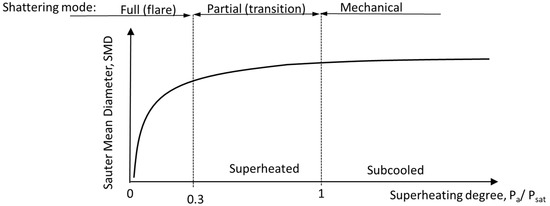
Figure 4.
Sauter mean diameter (SMD) vs. degree of superheat, modified from [1].
Figure 4 illustrates the relationship between the Sauter mean diameter (SMD) and the degree of superheat. When the liquid remains subcooled, and the ambient pressure is higher than the appropriate saturation pressure (pa/psat > 1), flashing does not occur, and instead, mechanical shear and hydrodynamic instabilities can lead to a breakup and atomization of the liquid. Full shattering (flare) is achieved for high degrees of superheat (pa/psat < 0.3). Numerous correlations exist for SMD, owing to its significance and convenient use. For a comprehensive overview of SMD correlations, the reader is referred to Konstantinov et al. [36].
Witlox et al. [37] and Kitamura et al. [38] discovered additional criteria for transitioning from partial to full-shattering regimes. These criteria were found in terms of Jakob and Weber numbers. Others provided transition criteria in terms of temperature ratio (, where Tc is the critical temperature of the fluid), and the depressurization rates. Figure 5 illustrates the required depressurization rate for the initiation of homogeneous nucleation, according to Elias Chambré [22]. As expected, the higher the temperature of the liquid prior to nucleation, the lower the depressurization rate required for the onset of homogeneous nucleation. At elevated liquid pressure and temperature values, the depressurization rate aspires to that of Hutcherson [39]. For further information, see Bar-Kohany and Levy [1].
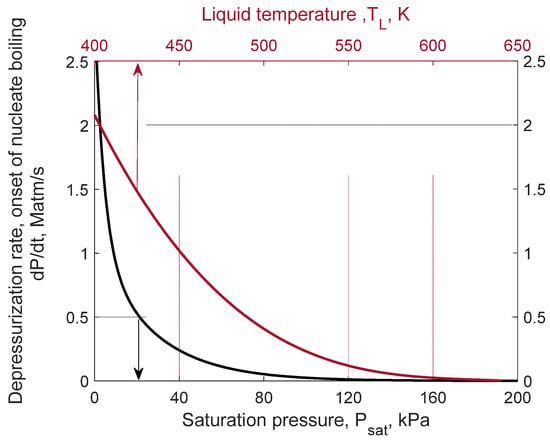
Figure 5.
Depressurization rate vs. saturation pressure for water (modified from [1]).
Lamanna et al. [40] presented a unified treatment of the fully flashing disintegration regime and found that bubble nucleation and growth are the controlling mechanisms for spray atomization in the fully flashing (flare) regime.
Three breakup patterns were identified by Loureiro et al. [41]:
- Retracing liquid. This occurs at low Webber numbers. When the surface tension forces are dominant, the liquid momentum is not sufficient to complete the breakup, and the ligaments pull the liquid back into larger droplets.
- Ligament stretching. When thick ligaments are subjected to larger momentum forces, the ligaments are stretched until their breakup, resulting in one large droplet per interstitial volume. This is equivalent to the assumption suggested originally by Sher and Elata [42].
- Thin lamella. When the momentum forces are large enough to overcome the viscous and surface tension forces, they lead to highly deformed bubbles. Along with the continuous evaporation of the liquid lamella, the thin liquid lamellas continue to be stretched with the growing bubbles, until they are broken into small bubbles.
Figure 6 presents the results for liquid oxygen (LOx) at 1 kPa for three different ambient temperature values .
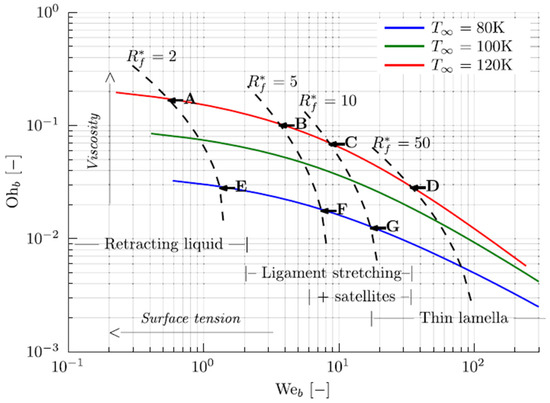
Figure 6.
Breakup patterns; results shown for liquid oxygen (LOx) at 1 kPa (Loureiro et al. [41]). depicts the bubble radius when it merges with another bubble, and depicts the critical bubble radius.
In the context of flash-boiling atomization, the following topics should be further pursued:
- Breakup patterns for various fluids in various conditions.
- Secondary breakup due to bubble formation within the larger droplets that continue to be superheated.
- Spray characteristics (droplet distributions, spreading angle, penetration length, etc.) as a function of the primary and secondary breakup processes.
2.3. Penetration Length and Spray Collapse
Short penetration length is an important parameter in sprays, particularly in combustion chambers, since it signifies that the liquid quickly disintegrates upon being expelled from the nozzle tip, thus increasing the liquid surface area, enhancing its vaporization rate, and improving its readiness for the required mixing and combustion. Short penetration length is also important for coating and painting processes, pharmaceutical applications, and more. Compared to mechanical methods, the penetration length of a spray generated by flash-boiling is known to be shorter, for a given pressure ratio [24].
The design of multi-hole injectors has been significantly accelerated over the last decade, and the spray penetration length can no longer be considered as the individual breakup length of each plume ejected by each hole but rather as the collapse length of all plumes together until they form a single spray cloud. Recent studies have shown the significance of the plumes’ interactions, and the pressure field that is being developed between and around them. The wider cone angles, which are typical of flash-boiling atomization, should be carefully controlled in the case of multi-hole injectors. For example, Wu et al. [43] showed that wider fuel plumes induced by flash-boiling led to an increased interaction between adjacent fuel plumes and, consequently, led to early collapse. They demonstrated that the spray penetration length is significantly dependent on the number of holes, their relative positioning, and the geometry. Kapusta [44] showed that the interaction between plumes strongly depends on the number and configuration of the plumes. He argued that while a two-nozzle injector allowed air flow into the core of the spray, the six-hole injector limits the entrainment of the external air, and thus the sprays could fully collapse. Li et al. [45] examined the conditions for spray collapse and found that apart from the overlapping of plumes, vapor condensation promotes spray collapse. They found that rapid bubble bursting caused a local static pressure rise that led to vapor condensation.
2.4. Fluids
In addition to the traditional fuel types (e.g., gasoline, diesel, aviation fuels, and oil fuels), there are ongoing efforts to explore a wide range of alternative fuels. Flash-boiling atomization is an excellent complementary technology to be used with some of them. Alternative fuels for spark-ignition (SI) engines are usually compressed natural gas, liquified petroleum gas, and alcohol fuels (methanol, ethanol, etc.) and their various blends and surrogates. It is worth noting that ethanol has an additional benefit; it can be readily produced from biomass [46]. Di-methyl-ether (DME), biodiesel, kerosene, and a jet propellent (JP-8) are more suitable for compression-ignition engines (CI) for ground and aeronautical transportation [47]. Space applications employ cryogenic propellants such as liquid oxygen (LOx) [48], and hypergolic propellants such as hydrazine and its derivatives. Novel developments of orbital maneuvering systems are focused on alternative fuels that are both eco-friendly and safer for operation. These include conventional options such as hydrogen, methane, and kerosene [40,41]). The ultra-fine droplets that can be obtained via the flash-boiling atomization of these alternative fuels have demonstrated potential in improving engine efficiency and reducing particulate matter emission (PM) thanks to the vigorous vaporization and the faster oxidation of the soot under flash-boiling conditions [49]. It has been observed that the utilization of alternative fuels in engines can necessitate certain adjustments in terms of the most favorable operation conditions. For example, higher latent heat of vaporization of ethanol, as compared to isooctane or hexane, for example, causes severe temperature drops during flash-boiling that significantly inhibit further vaporization. This leads to a less efficient ignition under cold-start ignition and possibly larger droplet size. Moreover, a larger fraction of ethanol increases density and viscosity in the spray penetration length. However, increasing the fuel temperature to promote a full flare (shuttering, see Section 2.2.2) breakup prevails and contributes to resolving both problems.
2.5. Diagnostics Aspects
Droplet distribution and velocity component statistics resulting from the primary breakup (see Section 2.2.2) play a crucial role in determining the spray quality. However, due to the dense population of droplets near the nozzle exit, it is very difficult to analyze the cloud optically [50]. Quantifying these statistics using optical diagnostic instruments is quite challenging, in particular where a flash billing spray is involved, as a faster breakup leads to a higher concentration of droplets.
Optical access to the flow inside the nozzle is imperative to a better understanding of flash-boiling atomization since it can provide essential data on the nucleation and bubbles’ growth and enable identification of flow patterns inside the nuzzle [51,52].
Several non-intrusive methods exist for diagnostics of internal and external flows during flash-boiling atomization. Most of the common diagnostic methods are optical, e.g., Shadowgraph, PIV (particle image velocimetry), various laser diagnostics, holography, etc. Consequently, much effort has been dedicated to the manufacturing of transparent nozzles [53], injectors, and cylinders [49]. The readers are referred to Yang et al. [54] for a broader review.
Measurements along the line of sight cannot distinguish between bubble structures of overlapping bubbles in the measurement direction. The results obtained using basic planar laser-based techniques may be hindered by significant multiple scattering within the multiphase medium, which could considerably distort optical measurements.
Ultra-short pulse off-axis digital holography was used by Minniti et al. [55]. Femto-second (fs), coherence length pulses, and reference beams were used to detect ballistic photons while eliminating the signal originating from the photons that had undergone multiple scattering events. This allowed the authors to map the primary spray cone with high accuracy and to circumvent the masking via an optically dense ancillary droplet shroud.
Cavicchi et al. [56] suggested a methodology based on local momentum flux measurements. Spray impact forcefully applied to small portions of the fluid structure was used to detect the individual local contribution of the liquid and gaseous phases to the jet momentum flux. One of the primary benefits of this diagnostic methodology is the ability to examine the spray pattern in close proximity to the nozzle (down to 4–5 mm from the tip) in a wide range of atomization quality and spray drop space density.
Transparent devices require materials with a refractive index that is very close to the liquid that is being examined, and, in some cases, strength and durability under high temperatures, to allow measurements near realistic engine operating conditions. Acrylic materials, for example, have a very close refractive index (1.4–1.5, [57]) to gasoline and diesel. On the other hand, acrylic material has a relatively low melting point that prevents its use in high-temperature fuel applications such as superheated fuels. Moreover, their optical qualities are sensitive to the corrosive interaction between the acrylic material and alcohol fuels. Glass material such as fused silica has favorable optical transmission properties over a broad range of wavelengths, and its refractive index is similar to one of common fossil fuels. However, their fabrication is more challenging and bears higher manufacturing costs. Aleiferis et al. [58] conducted a refractive index matching employing a liquid flow circuit around the test section.
In addition, it is worth noting the difference in the thermal properties of the various optical materials and the materials used in real operation [54]. Thus, it is still challenging to match the performance of optical injectors with real ones. When diagnostics are employed on non-transparent devices, X-ray radiography might be a useful tool, but its limitations should be considered. It currently suffers from line-of-sight measurement drawbacks. It is, however, anticipated that X-ray techniques will become increasingly more useful and informative in the future.
The valuable data collected from the different diagnostic tools is used to enhance our understanding of the flash-boiling atomization phenomena and to validate numerical codes.
3. Method of Analysis
Our analysis is based on the Web-of-Science database for the last 5 decades (1970–2023). Web-of-Science and Scopus are highly regarded sources and have long been the preferred databases for bibliometric analyses. These databases are well-suited for physical sciences, encompassing engineering and technology. It is worth noting that their journal coverages are quite comparable, as approximately 99.1% of the journals indexed in Web-of-Science can also be found in Scopus [59]. When searching the Web-of-Science database, one should employ a set of rules and filters to enhance search relevance and precision. The rules include Boolean operators (AND, OR, and NOT) for combining topics, titles, document types, language, and author keywords. Web-of-Science automatically finds spelling variations, such as US and UK spelling differences. The asterisk (*) represents any group of characters, and using quotation marks forces the search to find sources with the exact phrases stated between the quotation marks. More explanations and guidelines can be found on the Clarivate website. We used the following filtering criteria, as listed in Table 2.

Table 2.
Filtering criteria used for Web-of-Science query.
Scanning the Web-of Science database subject to the filtering criteria above resulted in 549 qualified articles. Further examination of the abstract of each article, excluded 163 articles that were found irrelevant (e.g., works that used the term “flash-boiling” in other disciplines where it is related to different phenomena). This left us with 386 articles that studied flash-boiling related to atomization and sprays. These articles are listed in Supplementary Materials, File S1-Database of flash-boiling atomization references (1970–2023). and are categorized by decades. Within each decade, the articles are listed chronologically, starting with the most recent and going back in time. Within each year, the articles are sorted alphabetically.
4. Overview of the Development of the Research Methods
4.1. Science Mapping—Evolution of Flash-Boiling Research
Owing to the significant advantage of liquid atomization by flash-boiling which drove a major growth of applications in different industries, the number of articles that have been published on the topic had increased dramatically, as shown in Figure 7. Although a few articles were published in the 1970s, it was not until the 1990s that a significant increase in the number of articles regarding flash-boiling atomization was observed. A dramatic increase in the available literature (more than 20 publications per year) since 2017, suggests that this research field has attracted high interest in recent years. The year 2022 demonstrates a sharp decline in the number of both publications and citations, probably due to the COVID-19 world situation (note that the database is updated to early 2023).
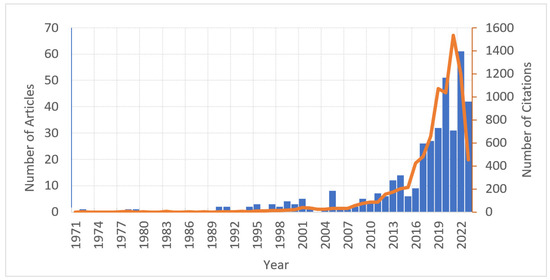
Figure 7.
Number of publications per year and number of citations per year (using Web of Science).
Coinciding with the number of articles, it seems that the research centers in the world that were engaged with this field shifted. Figure 8 presents the co-authorship overlay of countries for flash-boiling atomization in the last decade. It can be seen that Japan and Israel pioneered the research field while subsequently, the center of interest moved to the USA and Germany. During the last 5 years, the number of publications originating from England and China has significantly increased.
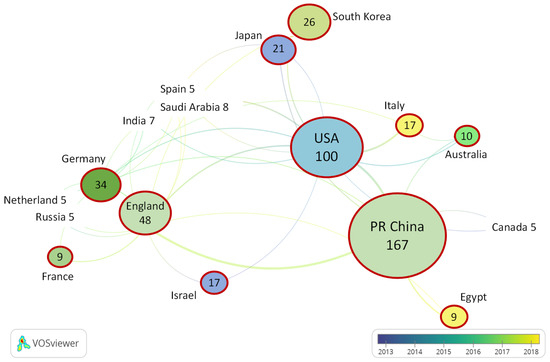
Figure 8.
The co-authorship overlay of countries and number of articles (the number depicted) for flash-boiling atomization research in the last decade (using Web of Science, based on the VOSviewer presentation plot).
The deep extensive research over the past 50 years contributed to our understanding of the basic sub-processes of flash-boiling atomization. The available combined databases and knowledge (experimental, numerical, and theoretical modeling) were noticeably improved. When analyzing the total number of research articles that were published in peer-reviewed journals in the English language, it is clearly seen that the majority of work was experimental in nature. These studies laid the necessary foundations for theoretical and numerical modeling, as depicted in Figure 9.
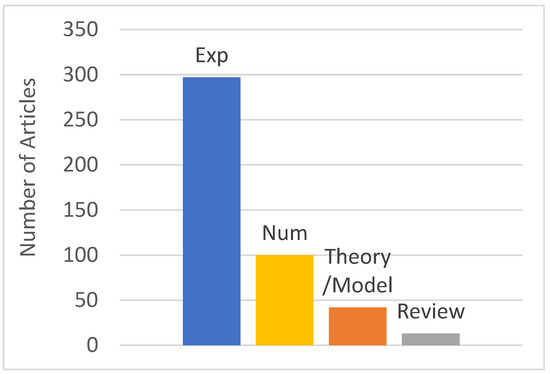
Figure 9.
Classification of the total published articles: experimental (Exp), numerical (Num), theoretical/modeling, and review articles over the past 50 years.
These works have been published in various scientific journals, the most notable of them is Fuel, followed by Atomization and Sprays, and Int. J. Heat and Mass Transfer (IJHMT). Figure 10 presents the number of documents that have been published on flash-boiling atomization in each journal over the years. Figure 11 presents the cited journal overlay in the last decade, considering the total link strength, which indicates the number of links of an item with other items [60].
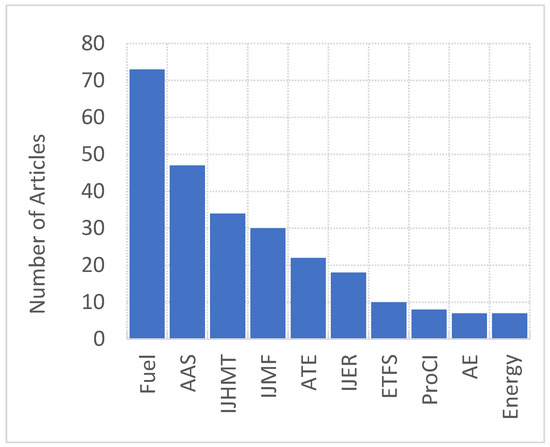
Figure 10.
Number of articles published in each journal over the last 50 years; AAS—Atomization and Sprays; IJHMT—Int. J. Heat and Mass Transfer; IJMF—Int. J. Multiphase Flow; ATE—Appl. Therm. Eng.; IJER—Int. J. Engine Research; ETFS—Exp. Therm. Fluid Sci.; ProCI—Proc. of the Combustion Inst.; AE—Applied Energy.
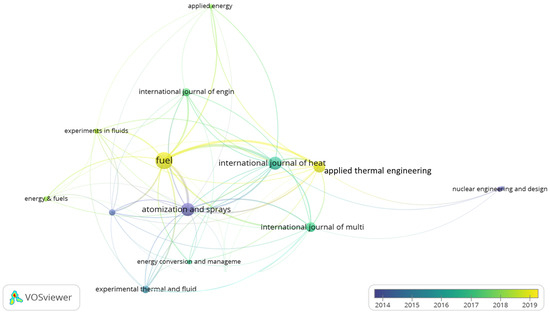
Figure 11.
Cited journal overlay in the last decade (using Web of Science and the VOSviewer presentation plot).
4.2. Categories and Applications
Flash-boiling atomization is a key process in a wide range of applications. Therefore, in-depth research is required to maximize its effect. A co-occurrence analysis is employed to explore the dynamic evolution of an academic domain by evaluating the frequency of pairs of words or noun phrases appearing in the whole body of literature in a specific domain [60]. Flash-boiling atomization research can be divided into several categories. Figure 12 shows the number of articles published in each category over the last 50 years. The figure reflects the major present worldwide interests.
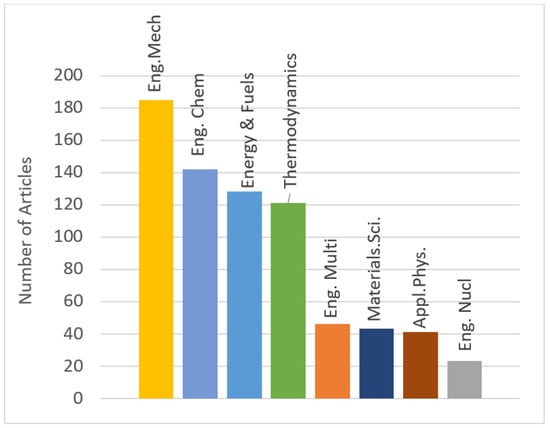
Figure 12.
Flash-boiling atomization classified by categories.
Figure 13 presents the number of published articles, classified by the alternative fuel and propellants being used. It is clearly seen that alcoholic fuels, such as ethanol and methanol, attracted high interest and special attention, followed by interest in cryogenic fuels, which are mostly relevant to space applications [48].
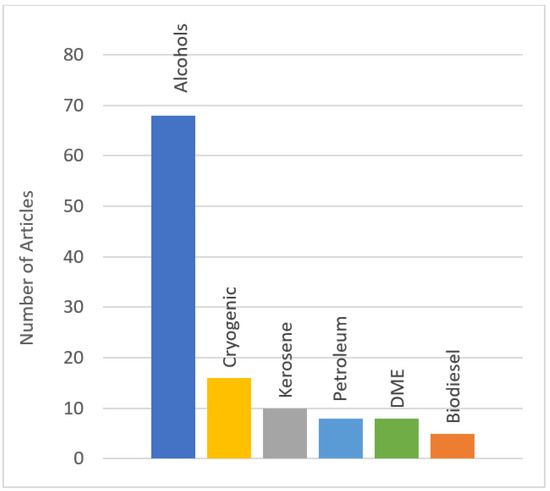
Figure 13.
Number of the published articles classified by the alternative fuel used in the last decade.
The number of articles published using the different diagnostic tools presented in Figure 14 demonstrates the current dominancy of the various laser methods (including LDV and Mie-scattering), followed by long-used shadowgraph and Schlieren methods. As mentioned in Section 2.5, X-ray radiography should be further developed to become more valuable for flash-boiling atomization diagnostics.
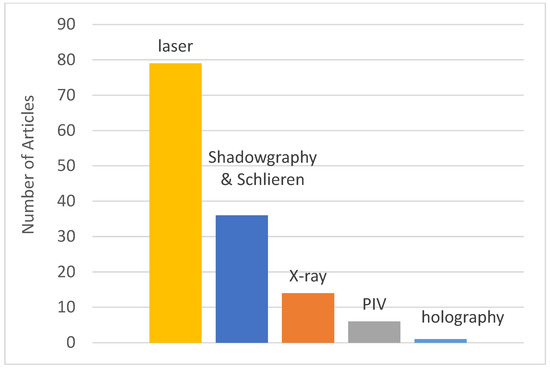
Figure 14.
Number of the published articles classified by diagnostic tool in the last decade.
4.3. Emerging Technologies
We have identified a few major front research and development directions (core issues) in flash boiling atomization. The more important one seems to be the one related to the mechanism of bubble nucleation. It is well accepted that compared to heterogeneous nucleation, homogeneous nucleation results in remarkably finer sprays, which play a crucial role in combustion chambers, pharmaceutical applications, coating, printing, and more. The need to shift from the well-established technology of heterogeneous nucleation to homogeneous nucleation is clear.
Another relatively new direction is the use of flash boiling atomization in internal combustion engines where alcoholic fuels are injected. Here, the multi-hole injector should be re-designed to accomplish flash boiling atomization while considering the interaction between the spray lobes to ensure high-quality sprays.
An additional emerging area is the use of special phenomena associated with employing negative absolute pressure to generate special sprays. This is quite a promising new direction in flash boiling atomization that invites both fundamental and applied science studies.
New experimental methods to observe the bubbly flow at the atomizer aperture is an important new step toward understanding the mechanism of nucleation and bubble growth under flash boiling atomization. These methods include Lazer, X-ray, and holography. New numerical methods have also flourished recently, but this topic is beyond the scope of this present article.
The aim of this article is to quantitatively portray the landscape and evolutionary trajectory of flash-boiling atomization research and applications and to detect new research frontiers and emerging trends in the flash-boiling atomization literature.
5. Conclusions
This present article quantitatively portrays the landscape and evolutionary trajectory of flash-boiling atomization research and applications, while detecting new research frontiers and emerging trends in the flash-boiling atomization literature. It provided a scientific mapping in which a non-predetermined exploration of the underlying structure and evolution of the flash-boiling atomization field is presented. The global overview is based on hundreds of citation data.
The bibliometric study yielded the following main observations and conclusions:
- The engagement of the scientific community has grown dramatically over the last decades—more than 20 publications per year since 2017. In addition, the involvement of research centers worldwide in this field appears to have undergone a shift. Illustration of the co-authorship connections between countries in the realm of flash-boiling atomization shows that Japan and Israel pioneered the research, followed by a growing interest from the United States and Germany. Notably, over the last 5 years, there has been a substantial increase in publications originating from England and China.
- The majority of the articles revolve around experimental studies. These empirical investigations play a vital role in establishing the fundamental groundwork for subsequent theoretical and numerical modeling.
- The research contributions have been disseminated across a range of scientific journals, with Fuel being the most prominent among them, followed by Atomization and Sprays, and Int. J. Heat and Mass Transfer.
- The emerging interest in various fuel types is expressed by the number of papers that study ethanol and methanol. In addition, there is a notable interest in cryogenic fuels, primarily associated with space applications.
- Tremendous progress has been made over the last couple of decades in diagnostic tools, mainly in laser, including LDV, and Mie-scattering, followed by the well-established shadowgraph and Schlieren methods and X-ray technologies.
We briefly review the basic theories of flash-boiling atomization mechanisms and present a comprehensive overview of the field from its birth, approximately in the 1970s to the present. We visualize the intellectual structure of flash-boiling atomization research and applications and track its evolvement over the past five decades, thus providing a comprehensive understanding of the development of flash-boiling atomization research and its emerging applications.
Flash-boiling atomization has proven to offer many important and crucial advantages where high-quality sprays (small-size droplets and narrow-size distribution) are essentially required. This is an important quality for efficient fuel combustion, pharmaceutical applications, coating, dyeing, printing, improved cold-start performance, and reducing emissions of pollutants. In addition, compared to other commonly used spraying methods, flash-boiling atomization requires significantly lower pressure difference for the same droplets’ size, and thus, operational safety is substantially increased.
While flash-boiling atomization offers many significant advantages, currently it faces several challenges which must be addressed to better understand this complex and fascinating process. A comprehensive knowledge of the following sub-processes will allow us to utilize its advantages optimally and correctly:
- Nucleation:
- Characterizing the nucleation pressure as a function of the depressurization rate.
- Identifying the effects of wettability, surface, and the reciprocal relations between surface roughness and the behavior of nano-bubbles, on nucleation flux.
- Improving the characterization of the nucleation process under special conditions, such as trans-critical conditions, and negative nucleation pressure.
- Bubble growth
- Identifying the effect of depressurization rates on bubble growth rates in both unconfined and confined liquid media (droplets, micro-channels, etc.).
- Validating bubble growth rates in the inertial regime that could be relevant to micron-sized droplets in a highly convective environment.
- Breakup
- Testing a variety of fluids (non/retrograde, cryogenic, etc.) exhibiting diverse breakup patterns under various conditions.
- Investigating the secondary breakup due to bubble formation within larger droplets, which remain superheated.
- Defining spray characteristics, such as droplet distributions, spreading angle, and penetration length, depending on both primary and secondary breakup mechanisms.
- Designing optimal multi-hole injectors considering the spray collapse.
- Testing flash-boiling atomization process in alternative fuels.
- Developing suitable fast and accurate diagnostics tools, including the use of X-rays. X-rays hold great promise for enabling real-time measurements in real operating conditions since it does not require visual transparency. It is expected that X-ray methods will continue to gain more significance in the near future.
Supplementary Materials
The following supporting information can be downloaded at: https://www.mdpi.com/article/10.3390/en16196763/s1, File S1: Database of flash-boiling atomization references (1970–2023).
Author Contributions
Conceptualization, methodology, and writing, T.B.-K. and E.S.; software, A.M., M.A. and T.B.-K. All authors have read and agreed to the published version of the manuscript.
Funding
This research received no external funding.
Acknowledgments
The authors acknowledge the financial support of Minerva Research Center (Max Planck Society Contract No. AZ5746940764).
Conflicts of Interest
The authors declare no conflict of interest.
References
- Bar-Kohany, T.; Levy, M. State of the art review of flash-boiling atomization. At. Sprays 2016, 26, 1255–1305. [Google Scholar] [CrossRef]
- Sovani, S.D.; Sojka, P.E.; Lefebvre, A.H. Effervescent atomization. Prog. Energy Combust. Sci. 2001, 27, 483–521. [Google Scholar] [CrossRef]
- Zeigerson-Katz, M.; Sher, E. Spray formation by flashing of a binary mixture: A parametric study. At. Sprays 1998, 8, 255–266. [Google Scholar] [CrossRef]
- Lefebvre, A.H.; McDonell, V.G. Atomization and Sprays; CRC Press, Taylor and Francis Group: Boca Raton, FL, USA, 2017. [Google Scholar]
- Ashgriz, N. Handbook of Atomization and Sprays: Theory and Applications; Springer Science & Business Media: Berlin/Heidelberg, Germany, 2011. [Google Scholar]
- Sher, E.; Zeigerson-Katz, M. Spray formation by flashing of a binary mixture: An energy balance approach. At. Sprays 1996, 6, 447–459. [Google Scholar] [CrossRef]
- Sazhin, S. Droplets and Sprays; Springer: London, UK, 2014. [Google Scholar]
- Sirignano, W.A. Fluid Dynamics and Transport of Droplets and Sprays; Cambridge University Press: Cambridge, UK, 2010. [Google Scholar]
- Solomon, A.S.P.; Chen, L.D.; Faeth, G.M. Investigation of Spray Characteristics for Flashing Injection of Fuels Containing Dissolved Air and Superheated Fuels; No. NAS 1.26; NASA: Washington, DC, USA, 1999; p. 3563. [Google Scholar]
- Skripov, V.P. Metastable Liquids; Wiley: New York, NY, USA, 1974. [Google Scholar]
- Carey, V.P. Liquid-Vapor Phase-Change Phenomena: An Introduction to the Thermophysics of Vaporization and Condensation Processes in Heat Transfer Equipment; CRC Press, Taylor and Francis Group: Boca Raton, FL, USA, 2018. [Google Scholar]
- Bar-Kohany, T. Minimal heating rate for isobaric nucleation at the spinodal in liquids. Int. J. Heat Mass Transf. 2021, 165, 120636. [Google Scholar] [CrossRef]
- Bar-Kohany, T.; Amsalem, Y. Nucleation temperature under various heating rates. Int. J. Heat Mass Transf. 2018, 126, 411–415. [Google Scholar] [CrossRef]
- Ching, E.J.; Avedisian, C.T.; Cavicchi, R.C.; Chung, D.H.; Rah, K.J.; Carrier, M.J. Rapid evaporation at the superheat limit of methanol, ethanol, butanol and n-heptane on platinum films supported by low-stress sin membranes. Int. J. Heat Mass Transf. 2016, 101, 707–718. [Google Scholar] [CrossRef]
- Glod, S.; Poulikakos, D.; Zhao, Z.; Yadigaroglu, G. An investigation of microscale explosive vaporization of water on an ultrathin pt wire. Int. J. Heat Mass Transf. 2002, 45, 367–379. [Google Scholar] [CrossRef]
- Shusser, M.; Weihs, D. Explosive boiling of a liquid droplet. Int. J. Multiphase. Flow. 1999, 25, 1561–1573. [Google Scholar] [CrossRef]
- Skripov, P.V.; Bar-Kohany, T.; Antonov, D.V.; Strizhak, P.A.; Sazhin, S.S. Approximations for the nucleation temperature of water. Int. J. Heat Mass Transf. 2023, 207, 123970. [Google Scholar] [CrossRef]
- Su, G.-Y.; Bucci, M.; McKrell, T.; Buongiorno, J. Transient boiling of water under exponentially escalating heat inputs. part i: Pool boiling. Int. J. Heat Mass Transf. 2016, 96, 667–684. [Google Scholar] [CrossRef]
- Avni, O.; Bar-Kohany, T.; Sher, E. Flash-boiling atomization triggered and driven by intensive radiation. Therm. Sci. Eng. Prog. 2022, 32, 101334. [Google Scholar] [CrossRef]
- Alamgir, M.; Lienhard, J.H. Correlation of Pressure Undershoot of Pressure During Hot Water Depressurization. J. Heat Trans. 1981, 103, 52–56. [Google Scholar] [CrossRef]
- Barták, J. Study of the Rapid Depressurization of Hot Water and the Dynamics of Vapour Bubble Generation in Superheated Liquid. Int. J. Multiph. Flow. 1990, 16, 789–798. [Google Scholar] [CrossRef]
- Elias, E.; Chambré, P.L. Flashing inception in water during rapid decompression. J. Heat Transf. 1993, 115, 231–238. [Google Scholar] [CrossRef]
- Moshkovich, Y.; Levy, Y.; Sher, E. Theoretical criteria for homogeneous flash-boiling atomization. Chem. Eng. Sci. 2019, 206, 471–475. [Google Scholar] [CrossRef]
- Sher, E.; Bar-Kohany, T.; Rashkovan, A. Flash-boiling atomization. Prog. Energy Combust Sci. 2008, 34, 417–439. [Google Scholar] [CrossRef]
- Avedisian, C.T.; Skyllingstad, K.; Cavicchi, R.C.; Lippe, C.; Carrier, M.J. Initiation of flash boiling of multicomponent miscible mixtures with application to transportation fuels and their surrogates. Energy Fuels 2018, 32, 9971–9981. [Google Scholar] [CrossRef]
- Prosperetti, A. Vapor bubbles. Annu. Rev. Fluid. Mech. 2017, 49, 221–248. [Google Scholar] [CrossRef]
- Mikic, B.B.; Rohsenow, W.M.; Griffith, P. On Bubble Growth Rates. Int. J. Heat Mass Trans. 1970, 13, 657–666. [Google Scholar] [CrossRef]
- Plesset, M.; Zwick, S.A. The growth of vapor bubbles in superheated liquids. J. Appl. Phys. 1954, 25, 493–500. [Google Scholar] [CrossRef]
- Mahmoud, M.M.; Karayiannis, T.G. Bubble growth on a smooth metallic surface at atmospheric and sub-atmospheric pressure. Int. J. Heat Mass Transf. 2023, 209, 124103. [Google Scholar] [CrossRef]
- Zanje, S.; Iyer, K.; Murallidharan, J.S.; Punekar, H.; Gupta, V.K. Development of generalized bubble growth model for cavitation and flash boiling. Phys. Fluids 2021, 33, 077116. [Google Scholar] [CrossRef]
- Jones, O.; Zuber, N. Bubble growth in variable pressure fields. J. Heat Transf. 1978, 100, 453–459. [Google Scholar] [CrossRef]
- Avedisian, C.T. Bubble growth in superheated liquid droplets. Encycl. Fluid Mech. 1985, 3, 130–190. [Google Scholar]
- Bar-Kohany, T.; Antonov, D.V.; Strizhak, P.A.; Sazhin, S.S. Nucleation and bubble growth during puffing and micro-explosions in composite droplets. Fuel 2023, 340, 126991. [Google Scholar] [CrossRef]
- Lightfoot, M. Fundamental classification of atomization processes. At. Sprays 2009, 19, 1065–1104. [Google Scholar] [CrossRef]
- Schulte, K.; Tropea, C.; Weigand, B. Droplet Dynamics under Extreme Ambient Conditions; Springer Nature: Berlin/Heidelberg, Germany, 2022. [Google Scholar]
- Konstantinov, D.; Marsh, R.; Bowen, P.J.; Crayford, A. Effervescent Atomization for Industrial Energy–Technology Review. At. Sprays 2010, 20, 525–552. [Google Scholar] [CrossRef]
- Witlox, H.; Harper, M.; Bowen, P.; Cleary, V. Flashing liquid jets and two-phase droplet dispersion: II. Comparison and validation of droplet size and rainout formulations. J. Hazard Mater. 2007, 142, 797–809. [Google Scholar] [CrossRef]
- Kitamura, Y.; Morimitsu, H.; Takahashi, T. Critical superheat for flashing of superheated liquid jets. Ind. Eng. Chem. Fund. 1986, 25, 206–211. [Google Scholar] [CrossRef]
- Hutcherson, M.N.; Henry, R.; Wollersheim, D. Two-phase vessel blowdown of an initially saturated liquid—Part 2: Analytical. J. Heat Transf. 1983, 105, 694–699. [Google Scholar] [CrossRef]
- Lamanna, G.; Kamoun, H.; Weigand, B.; Steelant, J. Towards a unified treatment of fully flashing sprays. Int. J. Multiph. Flow. 2014, 58, 168–184. [Google Scholar] [CrossRef]
- Loureiro, D.D.; Reutzsch, J.; Kronenburg, A.; Weigand, B.; Vogiatzaki, K. Primary breakup regimes for cryogenic flash atomization. Int. J. Multiph. Flow. 2020, 132, 103405. [Google Scholar] [CrossRef]
- Sher, E.; Elata, C. Spray formation from pressure cans by flashing. Ind. Eng. Chem. Process Des. Dev. 1977, 16, 237–242. [Google Scholar] [CrossRef]
- Wu, S.; Yang, S.; Wooldridge, M.; Xu, M. Experimental study of the spray collapse process of multi-hole gasoline fuel injection at flash boiling conditions. Fuel 2019, 242, 109–123. [Google Scholar] [CrossRef]
- Kapusta, Ł.J. Understanding the collapse of flash-boiling sprays formed by multi-hole injectors operating at low injection pressures. Energy 2022, 247, 123388. [Google Scholar] [CrossRef]
- Li, Y.; Guo, H.; Fei, S.; Ma, X.; Zhang, Z.; Chen, L.; Feng, L.; Wang, Z. An exploration on collapse mechanism of multi-jet flash-boiling sprays. Appl. Therm. Eng. 2018, 134, 20–28. [Google Scholar] [CrossRef]
- Fan, Y.; Sun, Z.; Gu, Q.; Xu, Q.; Li, X.; Xu, M. Combustion improved by using flash boiling sprays in an ethanol-gasoline optical engine under cold operating conditions. Energy Fuels 2021, 35, 10134–101345. [Google Scholar] [CrossRef]
- Bae, C.; Kim, J. Alternative fuels for internal combustion engines. Proc. Combust. Inst. 2017, 36, 3389–3413. [Google Scholar] [CrossRef]
- Lamanna, G.; Kamoun, H.; Weigand, B.; Manfletti, C.; Rees, A.; Sender, J.; Oschwald, M.; Steelant, J. Flashing behavior of rocket engine propellants. At. Sprays 2015, 25, 837–856. [Google Scholar] [CrossRef]
- Sun, Z.; Yang, S.; Nour, M.; Li, X.; Hung, D.; Xu, M. Significant impact of flash boiling spray on in-cylinder soot formation and oxidation process. Energy Fuels 2020, 34, 10030–10038. [Google Scholar] [CrossRef]
- Qiu, S.; Wang, S.; Zhang, Y.; Li, X.; Hung, D.; Xu, M. Dense-field spray droplet size quantification of flashing boiling atomization using structured laser illumination planar imaging technique. Fuel 2023, 335, 127085. [Google Scholar] [CrossRef]
- Wang, J.; Zhou, Z.; Chen, B.; Yang, T.; Zhang, L.; Romeos, A.; Giannadakis, A.; Panidis, T. Flow visualization of the transient effect of the internal two-phase flow on the external iso-pentane flashing spray under different injection pressure. Fuel 2023, 333, 126151. [Google Scholar] [CrossRef]
- Wang, S.; Qiu, S.; Zhang, Y.; Cui, M.; Li, X.; Xu, M. In-nozzle multi-phase flow patterns in flash-boiling atomization and their impacts on external sprays. Exp. Fluids 2023, 64, 48. [Google Scholar] [CrossRef]
- Wu, S.; Xu, M.; Hung, D.L.; Li, T.; Pan, H. Near-nozzle spray and spray collapse characteristics of spark-ignition direct-injection fuel injectors under sub-cooled and superheated conditions. Fuel 2016, 183, 322–334. [Google Scholar] [CrossRef]
- Yang, S.; Ma, Z.; Li, X.; Hung, D.L.; Xu, M. A review on the experimental non-intrusive investigation of fuel injector phase changing flow. Fuel 2020, 259, 116188. [Google Scholar] [CrossRef]
- Minniti, M.; Dunn-Rankin, D.; Chien, Y.C. Long-range microscopy of optically dense spray structures using ultra-short pulse off-axis digital holography. At. Sprays 2021, 31, 47–59. [Google Scholar] [CrossRef]
- Cavicchi, A.; Postrioti, L.; Sorbini, G.; Brizi, G. Local momentum flux measurement: An effective way for GDI spray targeting in flash-boiling conditions. Fuel 2022, 317, 123454. [Google Scholar] [CrossRef]
- Butcher, A.J.; Aleiferis, P.G.; Richardson, D. Development of a real-size optical injector nozzle for studies of cavitation, spray formation and flash-boiling at conditions relevant to direct-injection spark-ignition engines. Int. J. Engine Res. 2013, 14, 557–577. [Google Scholar] [CrossRef]
- Aleiferis, P.G.; Hardalupas, Y.; Kolokotronis, D.; Taylor, A.M.K.P.; Kimura, T. Investigation of the Internal Flow Field of a Diesel Model Injector Using Particle Image Velocimetry and cfd (No. 2007-01-1897); SAE Technical Article; SAE International: Warrendale, PA, USA, 2007. [Google Scholar]
- Singh, V.K.; Singh, P.; Karmakar, M.; Leta, J.; Mayr, P. The journal coverage of Web of Science, Scopus and Dimensions: A comparative analysis. Scientometrics 2021, 126, 5113–5142. [Google Scholar] [CrossRef]
- Van Eck, N.J.; Waltman, L. VOSviewer Manual. 24 January 2022. Available online: https://www.vosviewer.com/documentation/Manual_VOSviewer_1.6.18.pdf (accessed on 5 May 2023).
Disclaimer/Publisher’s Note: The statements, opinions and data contained in all publications are solely those of the individual author(s) and contributor(s) and not of MDPI and/or the editor(s). MDPI and/or the editor(s) disclaim responsibility for any injury to people or property resulting from any ideas, methods, instructions or products referred to in the content. |
© 2023 by the authors. Licensee MDPI, Basel, Switzerland. This article is an open access article distributed under the terms and conditions of the Creative Commons Attribution (CC BY) license (https://creativecommons.org/licenses/by/4.0/).